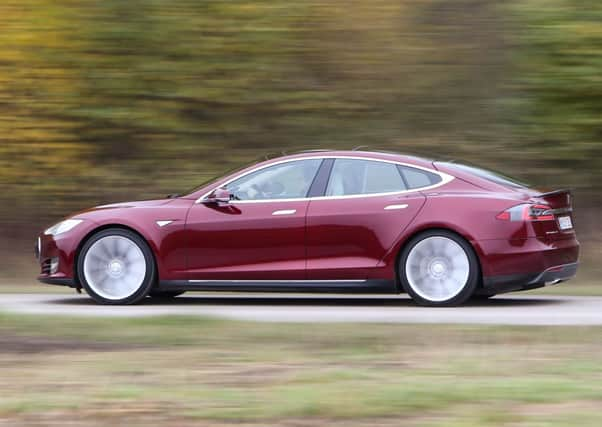First Drive: Tesla Model S P85+


Following the Roadster launched back in 2008, the Model S forms the lynchpin of his vision to put Tesla Motors on the map with a revolutionary way of incorporating electric power into a genuinely serious alternative to petrol power.
Naturally, the most important part of the car is the battery – the range-topping 85+ performance model we tested uses a 310kW pack churning out an equivalent of 416bhp and capable of finishing a 0-60mph sprint in just 4.2 seconds.
Advertisement
Hide AdAdvertisement
Hide AdApproach the car with the scaled down Tesla silhouette “key” in your pocket and the panel-flush door handles are presented to you with LED under-lighting – these then retract to aid the car’s slippery 0.24 drag co-efficient. Pull open the pillar-less doors and a whole new realm of interiors awaits.
Bar the hazard light knob and glovebox opener, the dashboard is almost completely devoid of buttons and is dominated by a giant 17-inch touchscreen controlling everything from the Google Maps navigation, media, energy management, vehicle data and cabin controls.
The Tesla was designed and built in California in Silicon Valley territory, so this technology makes sense, and works just as well. If you are familiar with smartphones and tablets it’s easy to operate and intuitive if you aren’t.
With no ignition to speak of, all you have to do to get going is press the brake pedal, slip the column-mounted gearshift into D and you’re off. In truth I was worried I’d be left hankering for an engine note to complement the Model S’s enormous power reserves, and anticipated being left feeling a little cold. But as soon as you stand on the throttle for the first time, this is all but forgotten; memories of symphonic V12’s and melodic V8’s were completely pushed to one side, and in their place comes a “whirring whoop” acceleration noise you will only have heard in Star Wars, reverberating through the bowels of the car to the hairs on the back of your neck – it’s utterly addictive.
Being 100 per cent electric, there is absolutely no lag or hesitation when you ask for some push – the acceleration is instant, and maximum torque is on offer at all times. And thanks to the weight-saving aluminium and clever steel press techniques used in its construction, along with the absence of a heavy engine, gearbox, drivetrain, exhaust or fuel tank, you feel every iota of performance has been eked out of the batteries.
The lack of conventional mechanical parts has freed up a significant amount of space inside; with no transmission tunnel, there is more oddment storage and a completely flat floor for rear passengers; the void in the engine bay acts as additional luggage space as a front trunk or “frunk”, and the rear hatchback and deep floor design allows for two additional seats if required.
In the centre of the instrument screen is an icon displaying the battery status, with how many typical miles of range you have remaining. You can recoup some miles with the regenerative braking system; it’s odd at first but you quickly learn to “one foot drive” and rarely need to use the brake pedal.
Buyers and fleet users will also enjoy virtually maintenance-free running, with no real servicing to speak of. If a software update becomes available, Tesla can simply send it to the car without your needing to visit a Tesla store – for instance, the “creep” function for driving in slow moving traffic was not previously available, but the system has been updated to include it.
Advertisement
Hide AdAdvertisement
Hide AdHowever, perhaps the biggest selling point will be the fuel savings – you will spend around £150 filling up a similarly powered petrol car, but Tesla reckon, depending on your tariff, that it will cost a maximum of £13 to fully charge a Model S, usually at a rate of 68 miles per hour of charging.
And taking into account the similar range that the Tesla yields compared to some fossil-fuelled rivals, petrol cars begin to look a little off the pace.
VITAL STATS
Price £69,080
Motor 310 kW (416bhp equivalent)
Performance Max speed 130 mph; 0-60mph 4.2s
Range 312 miles
CO2 emissions 0g/km